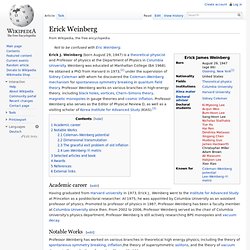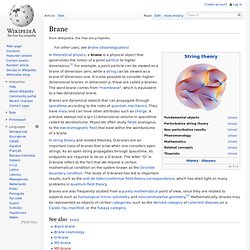

Erick Weinberg. Erick J.

Weinberg (born August 29, 1947) is a theoretical physicist and Professor of physics at the Department of Physics in Columbia University. Weinberg was educated at Manhattan College (BA 1968). He obtained a PhD from Harvard in 1973,[2] under the supervision of Sidney Coleman with whom he discovered the Coleman–Weinberg mechanism for spontaneous symmetry breaking in quantum field theory. Professor Weinberg works on various branches in high-energy theory, including black holes, vortices, Chern–Simons theory, magnetic monopoles in gauge theories and cosmic inflation. Professor Weinberg also serves as the Editor of Physical Review D, as well as a visiting scholar of Korea Institute for Advanced Study (KIAS).[3] Academic career[edit] Having graduated from Harvard university in 1973, Erick J.Weinberg went to the Institute for Advanced Study at Princeton as a postdoctoral researcher. Notable Works[edit] Holographic Universe by Michael Talbot.
One of the best books ever written!

I've read The Holographic Universe often, and have gained new insights into the nature of consciousness and reality from its riches every time. I consider it to be author Michael Talbot's most important work, as well as one of the best books ever written on the subject of so-called paranormal phenomenon. Talbot's fascination for finding scientific explanations for psychic and paranormal activity began when he noticed objects moving inexplicably around him, regardless where he lived.
He would sometimes awaken to find socks draped on his houseplants, and occasionally found objects in his apartment that he knew for a fact had been hundreds of miles away. His real-life experiences with such shifts in reality combined with his training in physics led him to explore possible reasons for these and other mysterious happenings. Was this review helpful? Higgs boson hints at vacuum bubble apocalypse - Story - Environment/Sci. Scientists studying data from the Large Hadron Collider have some bad news – their calculations suggest our universe will end catastrophically, devoured from within by a vacuum bubble expanding at the speed of light, destroying everything in its path.

Last year amid much fanfare, scientists said they had discovered a particle they believe is the Higgs boson, a previously missing link in the Standard Model of physics which gives particles mass. Further research backed up this theory, and as scientists learn more about it, the implications are becoming clear. "If you use all the physics that we know now and you do what you think is a straightforward calculation, it's bad news," says Joseph Lykken, theoretical physicist with the Fermi National Accelerator Laboratory in Illinois, who is also on the LHC team. "It may be that the universe we live in is inherently unstable and at some point billions of years from now it's all going to get wiped out. " 3 News. False vacuum. In quantum field theory, a false vacuum is a metastable sector of space that appears to be a perturbative vacuum, but is unstable due to instanton effects that may tunnel to a lower energy state.

This tunneling can be caused by quantum fluctuations or the creation of high-energy particles. Simply put, the false vacuum is a local minimum, but not the lowest energy state, even though it may remain stable for some time. This is analogous to metastability for first-order phase transitions. [citation needed] Stability and instability of the vacuum[edit] Diagram showing the Higgs boson and top quark masses, which could indicate whether our universe is stable, or a long-lived 'bubble'. Brane. In string theory and related theories, D-branes are an important class of branes that arise when one considers open strings.

As an open string propagates through spacetime, its endpoints are required to lie on a D-brane. The letter "D" in D-brane refers to the fact that we impose a certain mathematical condition on the system known as the Dirichlet boundary condition. The study of D-branes has led to important results, such as the anti-de Sitter/conformal field theory correspondence, which has shed light on many problems in quantum field theory. See also[edit] References[edit] Jump up ^ Moore, Gregory (2005). Cosmogony. Ultimate fate of the universe. The ultimate fate of the universe is a topic in physical cosmology.

Many possible fates are predicted by rival scientific theories, including futures of both finite and infinite duration. Once the notion that the universe started with a rapid inflation nicknamed the Big Bang became accepted by the majority of scientists,[1] the ultimate fate of the universe became a valid cosmological question, one depending upon the physical properties of the mass/energy in the universe, its average density, and the rate of expansion. There is a growing consensus among cosmologists that the universe is flat and will continue to expand forever.[2][3] The ultimate fate of the universe is dependent on the shape of the universe and what role dark energy will play as the universe ages.
Emerging scientific basis[edit] Multiverse. Theory of everything. A theory of everything (ToE) or final theory, ultimate theory, or master theory is a hypothetical single, all-encompassing, coherent theoretical framework of physics that fully explains and links together all physical aspects of the universe.[1]:6 Finding a ToE is one of the major unsolved problems in physics.

Over the past few centuries, two theoretical frameworks have been developed that, as a whole, most closely resemble a ToE. The two theories upon which all modern physics rests are general relativity (GR) and quantum field theory (QFT).